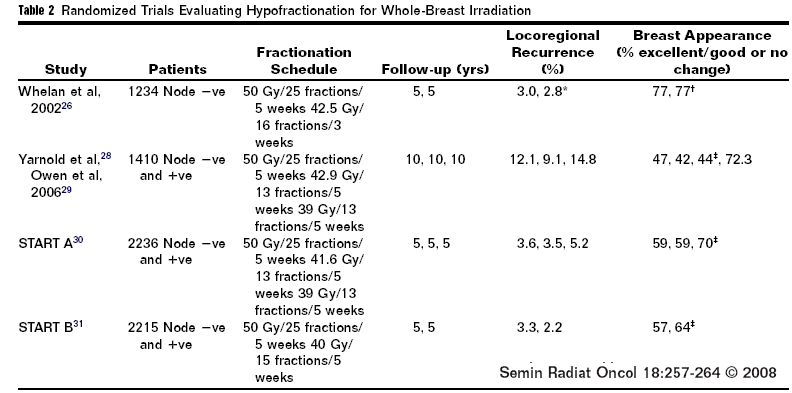. The randomized trial by Whelan (go here) published in 2002 showed excellent results and the 10 year follow up showed the same results (see below). Also see the table of completed studies on this subject as noted:
|
|
|
|
Accelerated radiation schedule effective, convenient
for early breast cancer
September 23, 2008
NEW YORK (Reuters Health), Sep 23 - In
women with node-negative early-stage breast cancer, an accelerated
dose-intensive course of radiation to the whole breast given over
three weeks provides good long-term control and limited late
morbidity, similar to that seen with the standard, less intensive
five-week course of whole-breast radiation.
That's according to long-term results of a randomized clinical trial reported Monday at the American Society for Therapeutic Radiology and Oncology's 50th Annual Meeting in Boston. "Given the benefits of convenience and cost, such an approach should be considered for women with early breast cancer," the investigators conclude.
In the study, 1,234 women with invasive breast cancer with pathologically clear margins and negative axillary nodes following lumpectomy were randomly allocated to accelerated hypofractionated whole-breast irradiation consisting of 42.5 gray (Gy) in 16 fractions over 22 days (the experimental arm) or 50 Gy in 25 fractions over 35 days (the conventional fractionation arm).
After 10 years, the risk of local recurrence was "very low" and not significantly different in women treated with the accelerated approach (6.2%) and those treated with the standard approach (6.7%), Dr. Timothy J. Whelan from McMaster University, Hamilton, Ontario, Canada, told the conference attendees. "The risk of local recurrence was clearly not any worse with the accelerated approach," he said.
In addition, the majority of patients in both groups had a good or excellent cosmetic outcome (70% and 71%, respectively). At 10 years, the incidence of moderate to severe late radiation morbidity to the skin was 6% in the three-week arm and 3% with the five-week arm, and for subcutaneous tissue the rates were 8% and 4%, respectively.
Putting the findings into perspective, Dr. Whelan said: "Randomized trials have shown that breast irradiation not only reduces the risk of recurrence of cancer in the breast and prevents the need for subsequent mastectomy, but also improves overall survival. Yet, we know that in North America about 20% to 30% of women don't receive whole-breast irradiation, in part because of the inconvenience of extended therapy for five to six weeks and in part because of the cost."
Not only is a three-week dose-intensive radiation course as effective and well-tolerated as the standard five-week course, Dr. Whelan said, "but it's also lower cost not only to the payor but to the patient who has to travel less for daily therapy."
Accelerated hypo fractionated whole-breast irradiation "provides a very useful and important option for women who wish to be treated in a shorter and more convenient approach," he concluded.

